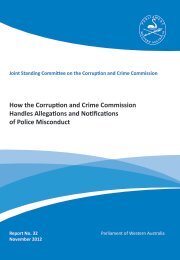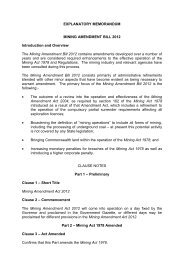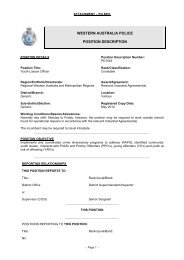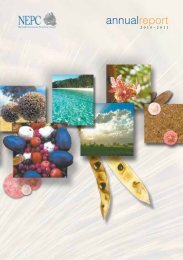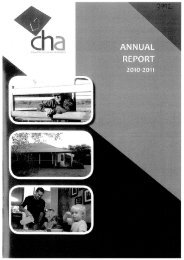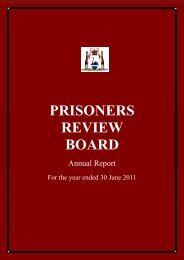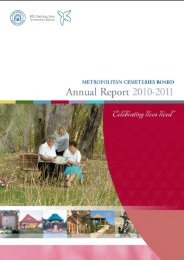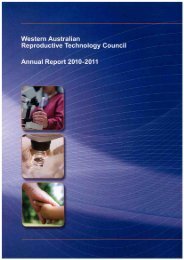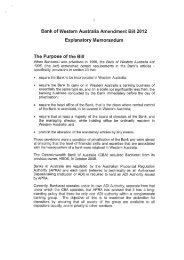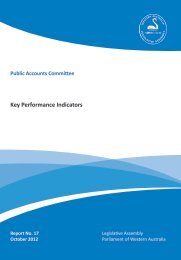Zoological Parks Authority - Parliament of Western Australia - The ...
Zoological Parks Authority - Parliament of Western Australia - The ...
Zoological Parks Authority - Parliament of Western Australia - The ...
Create successful ePaper yourself
Turn your PDF publications into a flip-book with our unique Google optimized e-Paper software.
<strong>Zoological</strong> <strong>Parks</strong> <strong>Authority</strong> ANNUAL REPORT 2012<br />
Agency Performance – Report on Operations<br />
Directorate Reports<br />
Life Sciences Directorate<br />
Overview<br />
In partnership with regional and global species<br />
management programs, the Directorate<br />
continued to focus on the operational and<br />
strategic management <strong>of</strong> the diverse range <strong>of</strong><br />
species held by the Zoo.<br />
In 2011‐12, significant births included two<br />
Sumatran Orangutans (critically endangered), a<br />
White-cheeked Gibbon (critically endangered),<br />
two Nepalese Red Panda (endangered), a litter<br />
<strong>of</strong> seven African Painted Dogs (endangered),<br />
Rothschild’s Giraffe (endangered), a litter <strong>of</strong> four<br />
Asian Small-clawed Otters (the first otters born<br />
at the Zoo for 18 years), eight Perenties, Bilby,<br />
Small-beaked Echidna and a Ghost Bat.<br />
In the reporting period, various animals were<br />
transferred in and out <strong>of</strong> the Zoo as part <strong>of</strong><br />
local, regional and global breeding and species<br />
management or recovery programs. <strong>The</strong>se<br />
transfers require significant staff expertise,<br />
preparation and coordination. Significant<br />
moves included the transfer <strong>of</strong> one <strong>of</strong> our<br />
male Sumatran Orangutans to Sumatra,<br />
Indonesia, for release into the wild as part<br />
<strong>of</strong> a reintroduction program; the arrival <strong>of</strong> a<br />
female African Lion from <strong>Western</strong> Plains Zoo in<br />
Dubbo; and the transfer <strong>of</strong> six Perth Zoo-bred<br />
Bush Stone Curlews to Narembeen for release<br />
into the Wadderin Sanctuary. New breeding<br />
animal arrivals included a female Meerkat from<br />
Newquay Zoo in the United Kingdom, a female<br />
Black-and-White Ruffed Lemur from Mogo<br />
Zoo in NSW and a male Emperor Tamarin from<br />
Apeldoorn in the Netherlands.<br />
Species Management<br />
In 2011‐12, the roles <strong>of</strong> the two Curatorial<br />
positions were realigned to enable one<br />
position to concentrate on operational<br />
and husbandry matters and the other to<br />
concentrate on species management planning<br />
and the Zoo’s extensive role in species<br />
management programs.<br />
In the reporting period, Perth Zoo supported<br />
40 species management programs with Perth<br />
Zoo staff coordinating 11 <strong>of</strong> these programs<br />
including the global program for the critically<br />
endangered Javan Gibbon and the regional<br />
programs for African Painted Dog, Ring-tailed<br />
Lemur, <strong>Western</strong> Swamp Tortoise and Shortbeaked<br />
Echidna. <strong>The</strong> Zoo’s support varies<br />
from holding small numbers <strong>of</strong> animals for<br />
educational purposes (e.g. Royal Spoonbill,<br />
African Lion) and holding post-reproductive<br />
animals to free up spaces at breeding<br />
institutions (such as the Tasmanian Devil), to<br />
being amongst the most significant breeding<br />
institutions for the species including Sumatran<br />
Orangutan, Red Panda, Short-beaked Echidna<br />
and Black-winged Stilt.<br />
35<br />
Fourteen Perth Zoo staff who act as Species<br />
Coordinators were provided with training on the<br />
complexities <strong>of</strong> species management and the<br />
principles <strong>of</strong> small population biology during<br />
the year.<br />
Outcomes<br />
Exotic Fauna<br />
A significant undertaking in 2011‐12 was the<br />
preparation, transfer and release <strong>of</strong> a Perth<br />
Zoo born Sumatran Orangutan, Semeru,<br />
into the wild in Sumatra, Indonesia, as part<br />
<strong>of</strong> a reintroduction program. Semeru was<br />
released in the same area <strong>of</strong> protected<br />
rainforest as another Perth Zoo born orangutan<br />
– female Temara – who was successfully<br />
released in 2006 (a world first for a zoo-born<br />
orangutan). <strong>The</strong> reintroduction program, run<br />
by the Frankfurt <strong>Zoological</strong> Society, is part <strong>of</strong><br />
international efforts to re-establish a population<br />
<strong>of</strong> this critically endangered species in the<br />
wild. <strong>The</strong> release <strong>of</strong> Temara and Semeru<br />
provides the opportunity to boost the numbers<br />
and genetic diversity <strong>of</strong> the reintroduced<br />
population (140 as at June 2012) in the Bukit<br />
Tigapuluh region <strong>of</strong> eastern Sumatra. <strong>The</strong> other<br />
reintroduced animals are rescued ex-pet or<br />
orphaned orangutans.



